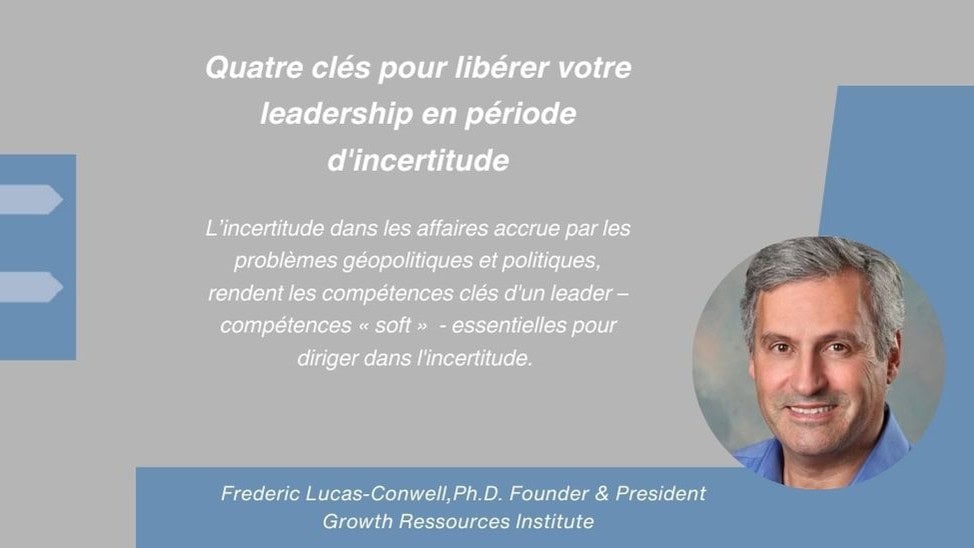
How to Unleash Your Leadership in Uncertain Times: The 4 Pillars
Uncertainty has become pervasive in our lives and in business. The Covid-19 pandemic marked a traumatic period, followed by geopolitical upheavals and a very turbulent macroeconomic environment. Unlike the 2008 crisis, which was mainly economic, we are now facing increased political and geopolitical uncertainty, and that is an understatement.
These uncertainties have transformed the way we work, blurring the boundaries between personal and professional life.
Leaders must now manage not only changes at the macroeconomic level, but also individual expectations around remote work, well-being, and societal issues such as environmental responsibility.
Human skills, also called “power skills”, are becoming essential. It’s not just about socializing or empathizing, but also about leading confidently through uncertainty, building on self-awareness and adaptability.
Leadership in times of uncertainty therefore requires a focus on strong human skills, the ability to inspire and adapt, and an understanding of team dynamics.
Behavioural profiles, such as those proposed by the GRI, are essential for understanding individual responses to stress and coping. They help identify natural behaviours and effectively adjust your leadership style to meet the needs of the team. Ultimately, each leader must consider not only their own energy, but also help their team proactively manage theirs, fostering collective resilience in the face of the challenges imposed by uncertainty.
Key One: Start with Self-Awareness
Self-awareness is crucial to cope with constant change. In a stressful environment, leaders must remain fully aware of their beliefs, assumptions, and purpose. This personal attention allows for self-development, positive influence on others, and fostering an authentic social conscience.
Second key: Manage with behavioral profiles in mind
The GRI Behavioural Profiles offer essential information about our attitudes towards change and reveal our natural tendencies and adaptive capacities. For example, a “Dominant” person sometimes has to learn to leave more room for others, while an “Impatient” person can develop by looking for opportunities that bring them more dynamism. Understanding our behavioural responses to stress helps us to adapt our reactions proactively.
Beyond self-awareness, the ability to adapt to others is another essential key. An effective leader understands and adjusts to the behavioral profiles of their team members, not just by intuition, but with a clear knowledge of their preferences and limitations. This awareness allows for the adjustment of group dynamics to maximize collaboration and efficiency, even in times of uncertainty.
Taking into account the different profiles helps to identify the best ways to work together, whether by encouraging “Social” people to participate fully in tense contexts or by allowing “Informants” to express their creativity without undue constraint. Every interaction, good or bad, is an opportunity for learning and continuous improvement.
Key Three: Surround Yourself with the Best Talent
In a world where concepts like “the Great Resignation” have become mainstream, the ability to select the right people to join your team is more crucial than ever. Hiring with a vision that goes beyond traditional technical skills uncovers talent that is often undervalued, but is able to learn and thrive with the right support. Using behavioral profiles in recruitment helps to overcome biases and align expectations between candidates and the organization, fostering strong and long-lasting relationships.
Good hiring decisions shape team dynamics in the long run. It is therefore essential to assess candidates in light of their behavioral traits to ensure that they will fit well into the work environment, while challenging biases and promoting diversity.
Key Four: Develop Your Key Behavioural Skills
Your soft skills are at the heart of modern leadership. It’s no longer just about “command and control” or “sell and persuade,” it’s about deeply understanding who your team members are, valuing them, and motivating them. Today’s generations are looking for meaning, appreciation, and opportunities for rapid growth. To meet these expectations, leaders must build relationships based on trust, listening, and understanding individual truths, while aligning them with the organization’s values.
The GRI’s behavioral language facilitates these connections. By reducing judgments and valuing differences, leaders are able to transform so-called “soft skills” into real assets, unleashing the energy and creativity of their teams. In times of uncertainty, it is this human approach that ensures productive collaboration and a shared vision.
Continuous leadership development
Leadership development is an ongoing process of learning and adapting. By using behavioral analytics, leaders can better understand not only their own needs but also those of others. This increased understanding promotes communication, accelerates learning and has a positive impact on performance. In these uncertain times, a proactive and thoughtful approach is key to building resilient and engaged teams that can thrive in an ever-changing world.

